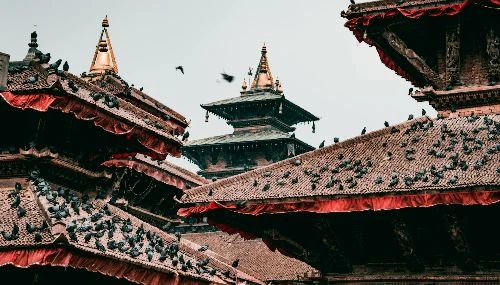December, January, and February are winter months in Nepal and therefore are the coldest months of the year. The mountain region, around an altitude of 3353m, has an alpine climate with considerably low temperatures in winter as expected. On a positive note, the Everest Base Camp trek is much quieter during this time. The lakes are frozen and snow makes the surrounding landscape remarkably picturesque.
During this time of the year, all of the mountain ranges become covered with snow and thus provide beautiful vistas. You will feel like you’ve stepped into a winter wonderland. In the winter it doesn't rain, so the temperature is bearable in the low land. However, during this time of year, there will be heavy snowfall in the high-altitude regions.
Temperatures are typically much colder during this time of the year, though the mountain views make the trip worth it. This is an excellent time to visit Everest Base Camp if you want a challenging, secluded adventure. Other Everest region treks also become less crowded due to people's worry that they can not bear the extremely low temperature, including Gokyo Valley Trekking, and Everest Panorama Trekking.
Generally, Everest Base Camp weather during December, January, and February is very cold i.e. cold at night and in the early mornings. Generally, high-altitude treks like Everest Base Camp Cho La Pass Trek are not recommended during this time of the year. However, both daytime and nighttime temperatures are bearable, and it’s possible to hike EBC during this time. But keep in mind, that you need to be well prepared with proper gear and equipment. Even when winter is at its most severe, it is compensated by the bright sun and brilliant views. The lower areas, averaging around 2000 meters above sea level, have a milder climate and you won’t have to worry too much about inclement weather.
The wind chill factor will make you feel much colder than the temperature suggests. Nepal's winter weather can range from cold and frosty to warm and sunny. The average temperature during these months is 17 °C. Sunny days can bring temperatures reaching about 25 °C whereas early mornings and nights drop to -15 °C in areas above 4000 meters. These temperatures are considered extreme by some, but the mountain views are often at their best and reward those who can bear the cold. In addition, you also don't have to compete for space along the trails or in the tea houses. You’ll have complete peace on the trail.
Everest Base Camp Weather in December
December is the beginning of the winter season. Temperatures drop well below freezing along with the majority of the trail at night. However, the daytime is usually sunny and clear. The snow-capped mountains against clear blue sky look spectacular. With proper gear and preparation, the trekking in December might turn out to be an amazing experience with a rewarding view of the landscapes.
Temperature: Throughout December, daytime temperatures will generally be around 4°C. At night the average minimum temperatures drop down to around -14°C.
Estimated Hours of Sunshine per Day: In December, expect the sun to shine for an average of 5-7 hours per day. This represents the average number of hours in the daytime when the sun is visible and not obscured by the clouds.
Wind: The average daily wind speed in December is around 12-19 k/hr (about 8-12 mph). The mornings and evenings are usually cold because of the fierce wind blows. However, the daytime is normal.
Everest Base Camp Weather in January
January is the coldest month in Nepal. Temperatures drop below freezing at night throughout the Everest region. Generally, during the daytime, it is quite sunny and while trekking, you’ll stay warm. Nepal's severe winter weather is at its peak in January. It is quite windy, so you've to face the challenging windchill. There are a few sunny, clear, and bright days. However, if you insist on trekking or if January is your only free month, it is possible to trek with the proper guidance and preparation. While packing gear, you have to prepare yourself for extreme weather conditions. There might be snowboards in high-altitude regions, so it is necessary to wear warm clothes.
Temperature: Throughout January, daytime temperatures will generally reach a maximum of 4°C. At night the average minimum temperature drops down to around -17°C.
Estimated Hours of Sunshine per Day: For January expect the sun to shine for an average of 5-7 hours per day. This represents the average number of hours in the daytime when the sun is visible and not obscured by the clouds.
Wind: The average daily wind speed in January is around 12-19 k/hr (about 8-12 mph).
Everest Base Camp Weather in February
In Nepal, February marks the end of the winter season just before spring arrives. In February, during the daytime, you can expect warm weather across most of Everest Base Camp.
At the end of the month, visibility is quite good as well. The temperature starts to increase gradually making the days warm. The snow along the trail starts to meltdown so, you need to be extra careful while walking as it might be slippery. Do not forget to wear shoes with a good grip. There might still be snowfalls so prepare yourself to stay warm in extreme conditions.
Temperature: Throughout February, daytime temperatures will generally be around 4°C. At night, the average minimum temperature drops down to around -14°C.
Estimated Hours of Sunshine per Day: For February expect the sun to shine for an average of 6 to 7 hours per day. This represents the average number of hours in the daytime when the sun is visible and not obscured by the clouds.
Wind: The average daily wind speed in February has been around 12-19 k/hr (about 8-12 mph).
Tips for trekking in December, January, and February
- Since it is very cold during the winter months, you must pack warm clothes to prepare for extreme weather conditions. Mornings are extremely cold and the temperature starts to increase gradually so you are recommended to wear clothes in layers.
- The days are shorter in winter so you need to start your trekking early in the morning.
- It is better to carry a sleeping bag with you. The teahouses will provide you with a warm bed but if the nights become extra cold it becomes handy.
- Do not forget to bring shoes with good grips which will help you cope with slippery trails. The trail during the day might be slippery as the snow melts down during the day.
- No matter how cold it gets do not forget to drink water and do not consume alcohol as it causes dehydration.
Note: All these available data are only estimated data based on past forecast data.

.jpg)

.webp)

